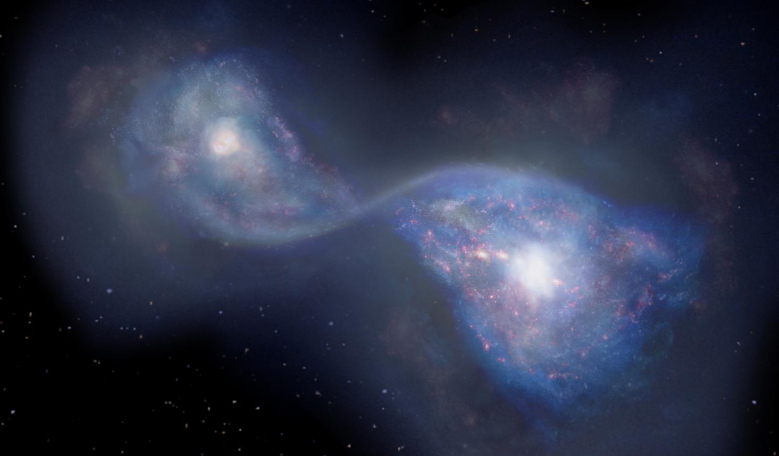A galaxy which is emitting signals of oxygen, carbon and dust has turned out to be the earliest example of a galaxy merger that occurred less than one billion years after the Big Bang.
Astronomers using the superb resolving power of the Atacama Large Millimeter/submillimeter Array (ALMA), detected the spectroscopic signs of these life essential elements, in an object known as B14-65666 located 13 billion light-years away in the constellation Sextans.
After a further analysis of the data, combined with previous observations with the Hubble Space Telescope (HST), the results showed that the atomic emissions come from a single system but are divided into two blobs. What’s more, these two blobs have different speeds – an indication that at one time they were two separate galaxies that have now merged. And at such a high redshift, this is not only the earliest example of a merger, but also the earliest galaxy where all three of these signals (oxygen, carbon and dust) have been detected.
The youthfulness of this galaxy in its prime is indicated by its apparent lack of star-forming material. The research team, headed by Takuya Hashimoto, a postdoctoral researcher at the Japan Society for the Promotion of Science and Waseda University, Japan, estimate that the total stellar mass of B14-65666 is less than 10 percent that of the Milky Way.
However, despite its relative paucity in gas and dust, the galaxy is 100 times more active than our own galaxy and churning out stars at a prodigious rate. This, say the research team, is the result of gas compression when the two blobs ploughed into one another.
"With rich data from ALMA and HST, combined with advanced data analysis, we could put the pieces together to show that B14-65666 is a pair of merging galaxies in the earliest era of the Universe," explains Hashimoto. "Detection of radio waves from three components in such a distant object clearly demonstrates ALMA's high capability to investigate the distant Universe."
Mergers are essential not only for star formation and galaxy evolution, but they also help unravel the evolution of the Universe, so naturally many astronomers are eager to trace back the history of mergers.
"Our next step is to search for nitrogen, another major chemical element, and even the carbon monoxide molecule," said Akio Inoue, a professor at Waseda University and second author on the research paper recently accepted in the Publications of the Astronomical Society of Japan. "Ultimately, we hope to observationally understand the circulation and accumulation of elements and material in the context of galaxy formation and evolution."











